A researcher is trying to construct a molecular-based phylogeny of the entire animal kingdom. Assuming that none of the following genes are absolutely conserved, which of the following genes would be the best choice on which to base the phylogeny? A) genes encoding enzymes involved in photosynthesis B) genes encoding enzymes involved in collagen synthesis C) genes that direct development of body axes D) genes involved in gastrulation
B
Which of the following characteristics is unique to animals? A) the structural carbohydrate, chitin B) nervous system signal conduction C) heterotrophy D) flagellated gametes
B
The larvae of some insects are merely small versions of the adult, whereas the larvae of other insects look completely different from adults, eat different foods, and may live in different habitats. Which of the following is most directly involved in the evolution of these variations in metamorphosis? A) artificial selection of sexually immature forms of insects B) changes in the homeobox genes controlling early development C) the evolution of meiosis D) the origin of a brain
B
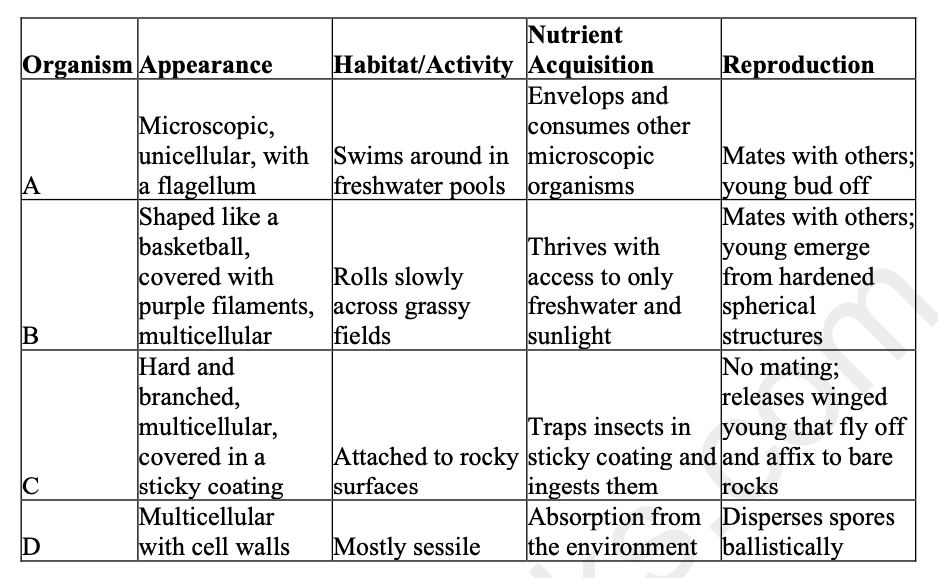
Use the table to answer the following question.
A researcher is studying animals on a previously undiscovered island, home to many unfamiliar
organisms, and decides to survey them using the research equipment at hand. The researcher
observes them in detail, and makes the notations shown in the table.
Which organism would you classify as an animal?
A) organism A
B) organism B
C) organism C
D) organism D
C
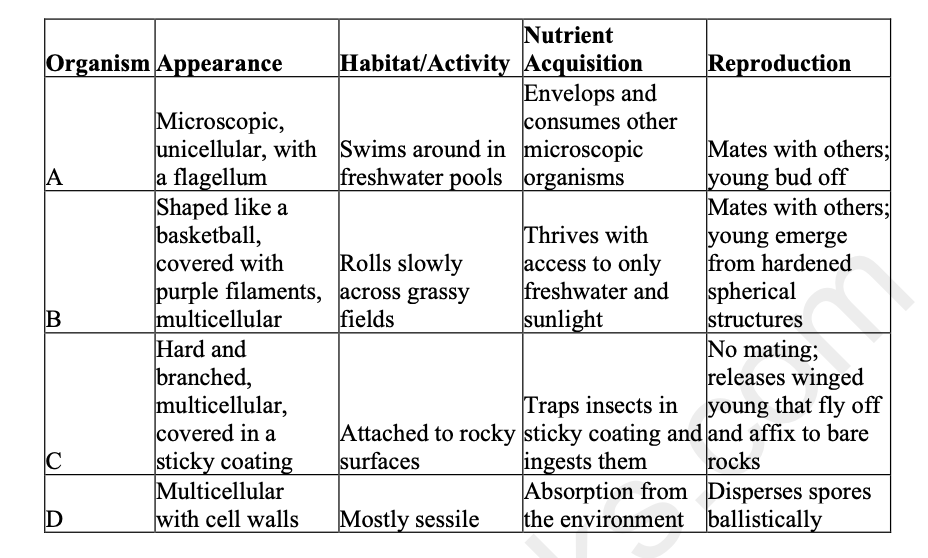
A researcher is studying animals on a previously undiscovered island, home to many unfamiliar
organisms, and decides to survey them using the research equipment at hand. The researcher
observes them in detail, and makes the notations shown in the table.
Which of the organisms listed is most likely to contain genes encoding enzymes that can fix
carbon from CO2?
A) organism A
B) organism B
C) organism C
D) organism D
B
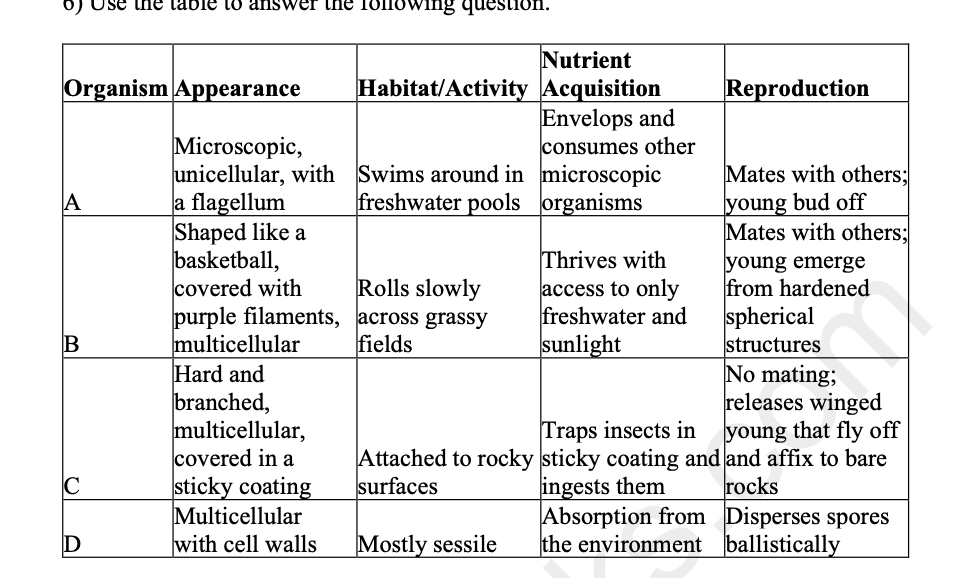
A researcher is studying animals on a previously undiscovered island, home to many unfamiliar
organisms, and decides to survey them using the research equipment at hand. The researcher
observes them in detail, and makes the notations shown in the table.
In which of the organisms listed would you most likely find collagen?
A) organism A
B) organism B
C) organism C
D) organism D
C
Both animals and fungi are heterotrophic. Which of the following distinguishes animal heterotrophy from fungal heterotrophy? A) most animals derive their nutrition by preying on other animals B) most animals derive their nutrition by ingesting materials C) most animals derive their nutrition by consuming living, rather than dead, prey D) most animals derive their nutrition by using enzymes to digest their food
B
Which of the following characteristics is common to all known animals? A) Animals are unicellular. B) Animals are multicellular. C) Animals are autotrophic. D) Animals have cell walls.
B
Which of the following characteristics is shared among animals ranging from corals to monkeys? A) a mouth and an anus B) number of embryonic tissue layers C) a lack of body symmetry D) sexual reproduction
D
In individual insects of some species, whole chromosomes that carry larval genes are eliminated from the genomes of somatic cells at the time of metamorphosis. As a result of the chromosome loss, which of the following consequences is most likely? A) cloning a larva from the somatic cells of such an adult insect would be difficult B) such species must reproduce only asexually C) sequencing of the entire genome will not be possible D) metamorphosis can no longer occur among the descendants of such adults
A
Which of the following organisms is most likely classified as something other than an animal? A) sponge B) coral C) jellyfish D) choanoflagellate
D
Which of the following processes contributed the most to the successful evolution of the millions of animal species? A) meiosis and sexual reproduction B) the arrangement of cells into tissues C) development of multicellularity D) the formation of an embryo and establishment of a basic body plan
C
Which of the following organisms was most likely the most recent common ancestor of all animals? A) unicellular chytrid B) multicellular algae C) multicellular fungus D) flagellated protist
D
Evidence of which structure or characteristic would be rare to find among fossils of the Ediacaran fauna? A) true tissues B) hard parts C) bilateral symmetry D) embryos
B
One hypothesis suggests that the Cambrian explosion was caused by the rise of predator-prey relationships. This hypothesis is best supported by an increased incidence of which of the following fossil traces? A) worm burrows B) larger animals C) organic material D) protective shells
D
Which of the following genetic processes may be most helpful in accounting for the Cambrian explosion? A) binary fission B) random segregation C) the origin of Hox genes and the addition of new microRNAs D) chromosomal condensation
C
Which of the following environmental changes is thought to have contributed to the Cambrian explosion? A) a decrease in oxygen levels in the atmosphere B) an increase in carbon dioxide levels in the atmosphere C) an increase in oxygen levels in the atmosphere D) a large meteor impact that spread ash into the atmosphere
C
Which of the following inferences can best be made from the fact that arthropods colonized land about 100 million years before vertebrates? A) arthropods evolved after vertebrates did B) extant terrestrial arthropods are better adapted to terrestrial life than are extant terrestrial vertebrates C) vertebrates evolved from arthropods D) arthropods have had more time to coevolve with land plants than have vertebrates
D
Which of the following factors most likely contributed to the extinction of many Ediacaran life forms? A) predation by new species, poisoning from high carbon dioxide levels, and loss of developmental flexibility B) predation by new species, poisoning from high oxygen levels, and loss of habitat due to increased temperatures C) predation by new species, faster movement by new species, and increased developmental flexibility by new species D) loss of habitat due to increased temperatures, poisoning from high oxygen levels, and loss of developmental flexibility
C
Which tissue type or organ is correctly matched with its germ layer tissue? A) nervous–mesoderm B) muscular–ectoderm C) stomach–mesoderm D) skin–ectoderm
D
While observing seawater through a microscope, you spot the embryo of an unknown animal. Which of the following criteria could you use to determine whether the organism exhibits protostome or deuterostome development? A) the development of germ layers B) spiral cleavage or radial cleavage C) the development of a blastopore D) the development of an archenteron
B
In examining an unknown animal species during its embryonic development, how can you be sure what you are looking at exhibits protostome or deuterostome development? A) There is evidence of cephalization. B) The animal is triploblastic. C) The animal is clearly bilaterally symmetrical. D) The animal's coelom develops from the archenteron.
D
Which of the following is a feature of the digestive tube in most animal phyla? A) The outer tube consists of a hard exoskeleton. B) The outer tube consists of digestive organs. C) The mouth and anus form the ends of the inner tube. D) The two "tubes" are separated by tissue that comes from embryonic endoderm.
C
In the earthworm body plan, the digestive system can be described as a "tube-within-a-tube." Where would you expect to find most of the tissues that developed from endoderm? A) lining the straw B) lining the space between the pipe and the straw C) forming the outside of the pipe D) forming the outside of the straw
A
Among organisms exhibiting protostome development, which morphological trait shows the most variation? A) type of symmetry B) type of body cavity C) number of embryonic tissue types D) type of cell cleavage
B
What do many organisms with deuterostome development have in common? A) Adults are bilaterally symmetrical. B) Embryos have pharyngeal pouches that may or may not form gill slits. C) All have a spinal column. D) The blastopore formed during gastrulation becomes the anus.
D
Soon after the coelom begins to form, a researcher injects a dye into the coelom of a deuterostome embryo. Into which of the following structures would you expect the dye to flow? A) blastopore B) blastocoel C) archenteron D) hemocoel
C
Which of the following characteristics in an organism would indicate that it lacks a coelom? A) It is triploblastic. B) It has bilateral symmetry. C) It possesses sensory structures at its anterior end. D) Muscular activity of its digestive system distorts the body wall.
D
One small animal phylum (Placozoa) contains only two species, Trichoplax adhaerens (T. adhaerens) and T. reptans. There are four types of cells, none of which are nerve or muscle cells, and none of which have cell walls. T. adhaerens sperm cells have never been observed. Embryos up to, but not past, the 64-cell (blastula) stage have been observed. On the basis of information in the paragraph, which of these should be able to be observed in T. adhaerens? A) a coelom B) the process of gastrulation C) eggs D) a radially symmetric larval form
C
A student encounters an animal embryo at the eight-cell stage. The four smaller cells that comprise one hemisphere of the embryo seem to be rotated 45° and to lie in the grooves between larger, underlying cells. Which of the following organisms is this embryo most likely to develop into? A) turtle B) earthworm C) sea star D) sea urchin
B
A student encounters an animal embryo at the eight-cell stage. The four smaller cells that comprise one hemisphere of the embryo seem to be rotated 45° and to lie in the grooves between larger, underlying cells. If we were to separate these eight cells and attempt to culture them individually, then what is most likely to happen? A) All eight cells will die immediately. B) Each cell may continue development, but only into a nonviable embryo that lacks many parts. C) Each cell may develop into a full-sized, normal embryo. D) Each cell may develop into a smaller-than-average, but otherwise normal, embryo.
B
Which of the following was an early selective advantage of a coelom in animals? A) it contributed to a hydrostatic skeleton, allowing greater range of motion B) it was a more efficient digestive system C) it allowed cephalization and the formation of a cerebral ganglion D) it allowed asexual and sexual reproduction
A
The protostome developmental sequence arose just once in evolutionary history, resulting in two main subgroups–Lophotrochozoa and Ecdysozoa. What does this finding suggest? A) These two subgroups have a common ancestor that exhibited deuterostome development. B) Division of these two groups occurred before the protostome developmental sequence. C) Division of these two groups occurred after the protostome developmental sequence appeared. D) The lophotrochozoans are monophyletic.
C
Which of these statements, if accurate, would support the claim that the ancestral cnidarians had bilateral symmetry? A) Cnidarian larvae possess anterior-posterior, left-right, and dorsal-ventral aspects. B) Cnidarians have fewer Hox genes than bilaterians. C) All cnidarians lack a coelom. D) The presence of collar cells.
A
If an organism exhibits a head with sensory structures, which of the following characteristics would it likely also exhibit? A) it is bilaterally symmetrical B) it has a coelom C) it is segmented D) it is diploblastic
A
Suppose a researcher for a pest-control company developed a chemical that inhibited the development of an embryonic mosquito's endodermal cells. Which of the following best explains the effectiveness of the pesticide? A) The mosquito would develop a weakened exoskeleton that would make it vulnerable to trauma. B) The mosquito would have trouble digesting food, due to impaired gut function. C) The mosquito would have trouble with respiration and circulation, due to impaired muscle function. D) The mosquito wouldn't be affected at all.
B
Trichoplax adhaerens is the only living species in the phylum Placozoa. Individuals are about 1 mm wide and only 27 μm high, and are irregularly shaped. There are four types of cells, none of which are nerve or muscle cells, and none of which have cell walls. Individual animals move using cilia, and feed on marine microbes. The body symmetry of T. adhaerens is likely to be most similar to which of the following groups of organisms? A) most sponges B) cnidarians C) worms D) tetrapods
A
Which of the following characteristics represents the oldest branch point in animal phylogeny? A) radial or bilateral symmetry B) diploblastic or triploblastic embryos C) true tissues or no tissues D) a body cavity or no body cavity
C
Which of the following statements is correct regarding animal body plans? A) organisms direct their own evolution in order to maximize their success B) animals evolve according to a pre-ordained plan C) the body plans we see now have been evolutionarily advantageous compared to others in the past D) mutations have arisen that allow only some shapes to be produced
C
Body symmetry in animals affects swimming in which of the following ways? A) Radial symmetry is more advantageous for active swimming than is bilateral symmetry. B) Radial symmetry occurs most frequently in animals that catch their prey by rapid swimming. C) Bilateral symmetry allowed animals to evolve nerves. D) Bilaterally symmetric animals can be streamlined for swimming, but radially symmetric animals cannot.
D
What is the primary difference between a coelom and a hemocoel? A) their developmental origin B) the manner in which they cushion the internal organs C) a coelom arises in the ectoderm, and a hemocoel arises in the endoderm D) a coelom occurs in triploblastic animals, and a hemocoel occurs in diploblastic animals
A
Nine-banded armadillos give birth to four genetically identical offspring at a time. What does this fact suggest about the development of these organisms? A) the young undergo metamorphosis B) the embryo undergoes radial and indeterminate cleavage C) the first cell division of the fertilized egg is perpendicular to the vertical axis of the egg D) the species has a hemocoel
B
You find a new species of worm and want to classify it. Which of the following lines of evidence would allow you to classify the worm as a nematode and not an annelid? A) It is segmented. B) It is triploblastic. C) It has a coelom. D) It sheds its external skeleton to grow.
D
The last common ancestor of all bilaterians is thought to have had four Hox genes. Most extant cnidarians have two Hox genes, though some have three Hox genes. On the basis of these observations, some scientists have proposed that the ancestral cnidarian's were originally bilateral and, in stages, lost Hox genes from their genomes. If true, what would this mean regarding the phylogeny of animals? A) all radially symmetric animals should be grouped together in one clade B) the radial symmetry of extant cnidarians is secondarily derived, rather than being an ancestral trait C) Hox genes play little actual role in coding for an animal's "body plan" D) cnidaria may someday replace porifera as the basal bilaterians
B
Some researchers claim that sponge genomes have homeotic genes, but no Hox genes. If true, how would this impact the phylogenetic tree of animals? A) sponges must no longer be classified as animals B) it would confirm the identity of sponges as "basal animals" C) extinct sponges must have been the last common ancestor of animals and fungi D) it would require sponges to be reclassified as choanoflagellates
B
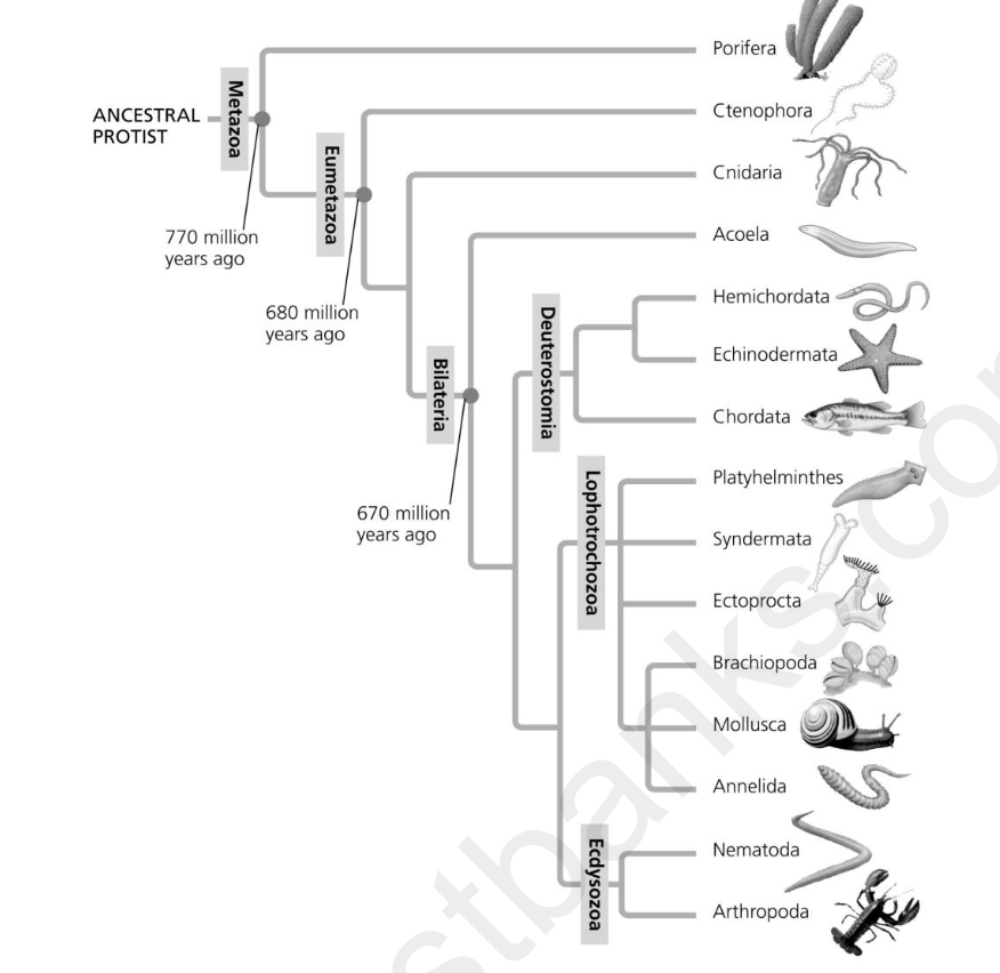
Which of the following statements is correct according to the phylogeny in the figure?
A) Chordata and Mollusca share a more recent common ancestor than Arthropoda and Nematoda
B) Porifera evolved after Cnidaria
C) Hemichordata and Echinodermata share a more recent common ancestor than Annelida and
Nematoda
D) Most animals belong to the Ecdysozoa clade
C

Which of the following statements is consistent with the phylogeny in the figure?
A) Deuterostomia evolved before Porifera.
B) Ecdysozoa evolved before Deuterostomia.
C) Porifera are more closely related to Acoela than they are to Ctenophora.
D) Porifera are more closely related to Ctenophora than they are to Acoela.
D

Which of the following characteristics defines a structural distinction between Chordata and
Brachiopoda?
A) Both groups have tissues.
B) Brachiopoda have a lophophore and Chordata do not.
C) Both groups exhibit bilateral symmetry.
D) Both groups shed their external skeletons.
B
Which of the following is an advantage of using molecular data rather than morphological data for phylogenetic analysis? A) Molecular data can be gathered in the lab, while morphological data must be gathered in the field. B) Molecular data is based on genetic relationships rather than morphological similarities. C) Morphological changes usually do not result from molecular changes. D) Some phyla vary too widely in morphological characteristics to be classified accurately.
B
Which of the following statements concerning animal taxonomy is accurate? A) Animals are thought to have evolved from flagellated protists similar to modern choanoflagellates. B) Kingdom Animalia is polyphyletic. C) Animals are more closely related to plants than to fungi. D) In the kingdom Animalia, most clades based on body plan confirm clades based on molecular data.
A
Which of the following statements regarding the diversification of animals is supported by the current available evidence? A) most animals belong to the clade Bilateria B) animals descended from multiple ancestors C) ctenophores are basal metazoans D) sponges are a paraphyletic group of organisms
A
At one time, sponges were lumped into one phylum. Then, they were separated into several different phyla. Now, they are considered one phylum again. These changes indicate which of the following? A) Every phylogeny should be considered a hypothesis that must be revised in the light of new data. B) We need more fossil evidence of sponges. C) Molecular and morphological data often conflict when we try to reconstruct evolutionary history. D) The goal of making all taxonomic groups monophyletic is unrealistic.
A
Sponges and ctenophores have both been proposed as basal metazoans. Which of the following types of data support the idea that sponges are the basal group? A) sequences of cadherin genes, cleavage type, structure of collar cells, and bilateral symmetry of adults B) sequences of collagen genes, bilateral symmetry of adults, cleavage type, and fossil steroids C) recent phylogenomic evidence, fossil steroid evidence, molecular clock, lack of tissues in sponges, and structure of collar cells D) structure of collar cells, bilateral symmetry of larvae, sequences of cadherin genes, and molecular clock
C
Placing sponges as the basal metazoans on the basis of lack of tissues implies which of the following? A) Sponge ancestors never had tissues. B) Modern-day sponges have lost the ability to form tissues. C) Multicellular, modern-day choanoflagellates can form tissues. D) Sponges do not have nerve cells.
A
One of the characteristics unique to animals is ________. A) gastrulation B) multicellularity C) sexual reproduction D) flagellated sperm
A
The distinction between sponges and other animal phyla is based mainly on the absence versus the presence of ________. A) a body cavity B) a complete digestive tract C) mesoderm D) tissues
D
Which of the following was probably an important factor in bringing about the Cambrian explosion? A) the movement of animals onto land B) an increase in the concentration of atmospheric nitrogen C) the emergence of predator-prey relationships D) the origin of bilaterian animals
C
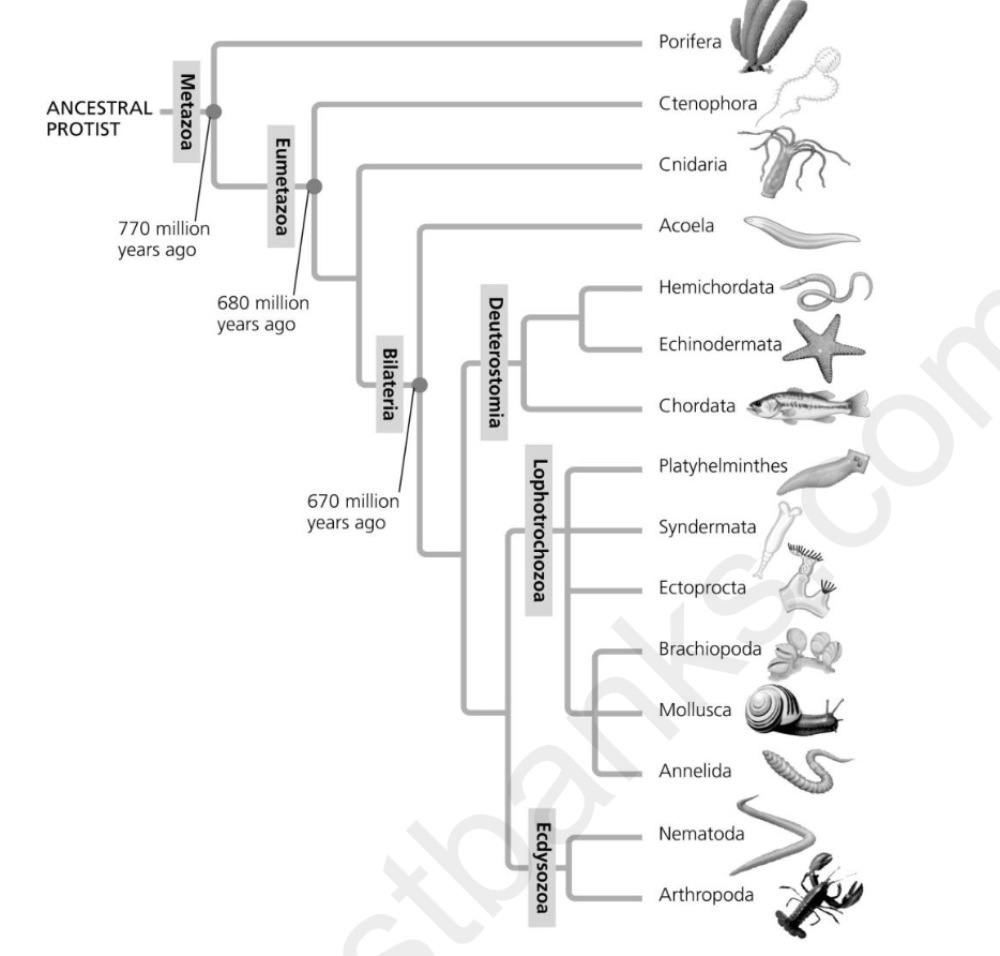
Based on the tree, which statement is true?
A) The animal kingdom is not monophyletic.
B) The Acoela are more closely related to echinoderms than to annelids.
C) Sponges are basal animals.
D) Bilaterians do not form a clade.
C